Why you can trust Tom's Hardware
Our standard benchmarks and power tests are performed using the CPU’s stock frequencies (including any default boost/turbo), with all power-saving features enabled. We set optimized defaults in the BIOS and the memory by enabling the XMP profile. For this baseline testing, the Windows power scheme is set to balanced (default), so the PC idles appropriately.
To get the most out of the Intel Alder Lake chips, you need to be on Windows 11 with its updated scheduler. In most cases, Windows 10 performs well. However, some tests (Cinebench R20, Corona and POVRay) take a significant hit. In short, if you’re going with Alder Lake, you must upgrade to Windows 11 for the best results across the board. That may change with patching and updates in the future, though.
Synthetic Benchmarks
Synthetics provide a great way to determine how a board runs, as identical settings should produce similar performance results. Turbo boost wattage and advanced memory timings are places where motherboard makers can still optimize for either stability or performance, though, and those settings can impact some testing.


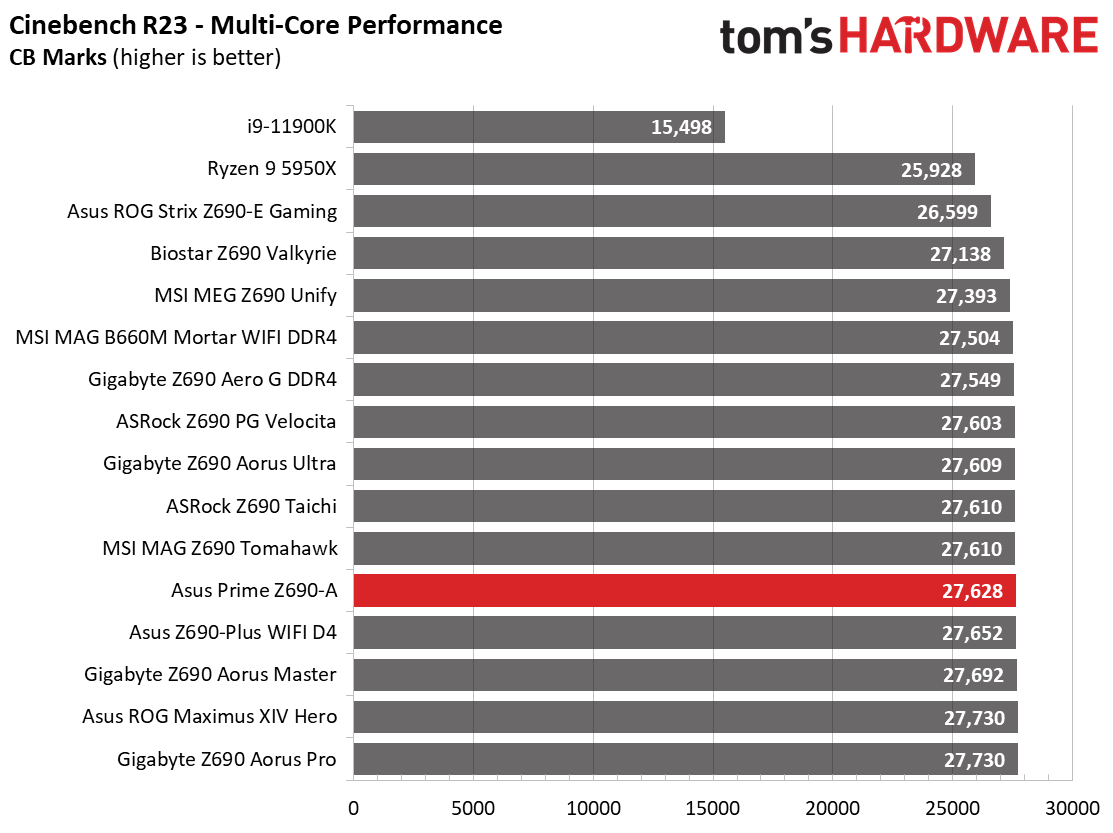



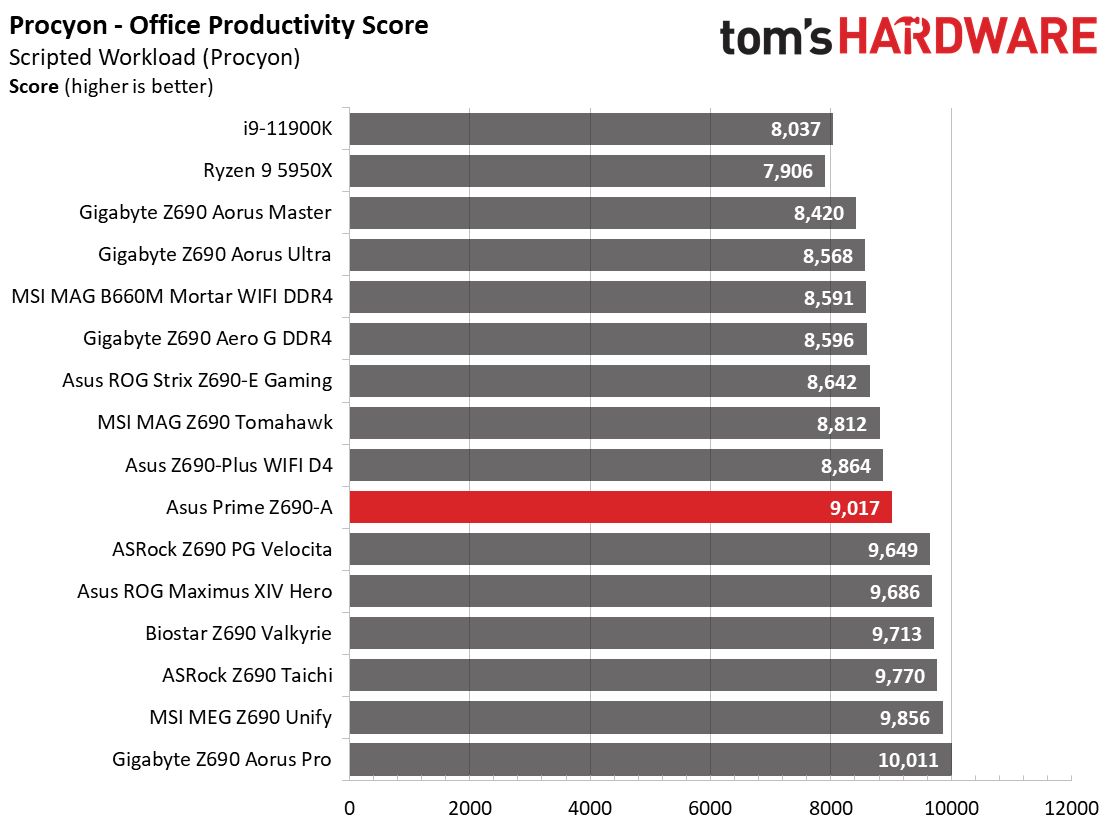





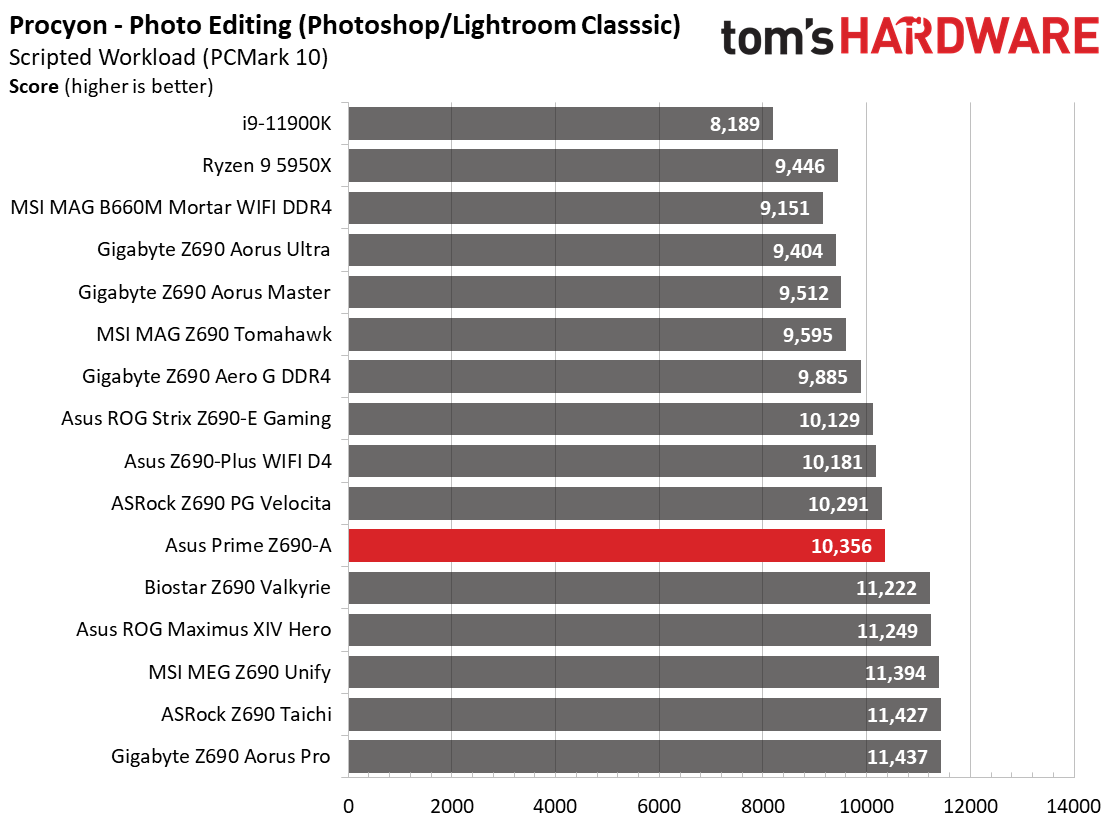




The Prime Z690 PG Velocita traded punches with the other Z690 boards we’ve tested so far. It wasn’t the fastest or slowest in any benchmark, but it was faster than average overall.
Timed Applications

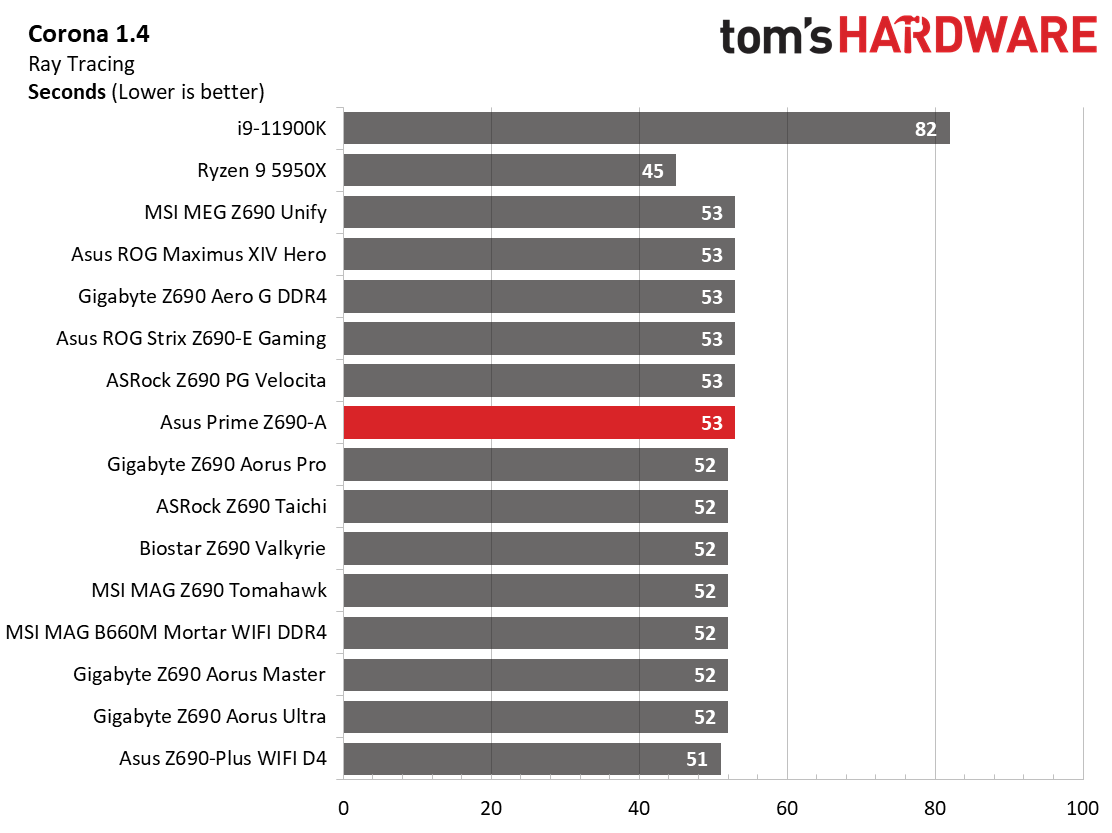


In these tests, the Prime Z690 was average, except for the LAME test, where it ran 9.50 seconds, matching the fastest result. Mind you, in the LAME tests, the difference between the fastest and slowest is only a couple of percent, but it is still tied for the fastest. Outside of that, the Corona results (53 seconds) were average, as were both Handbrake tests. There’s nothing to worry about here either.
3D Games and 3DMark
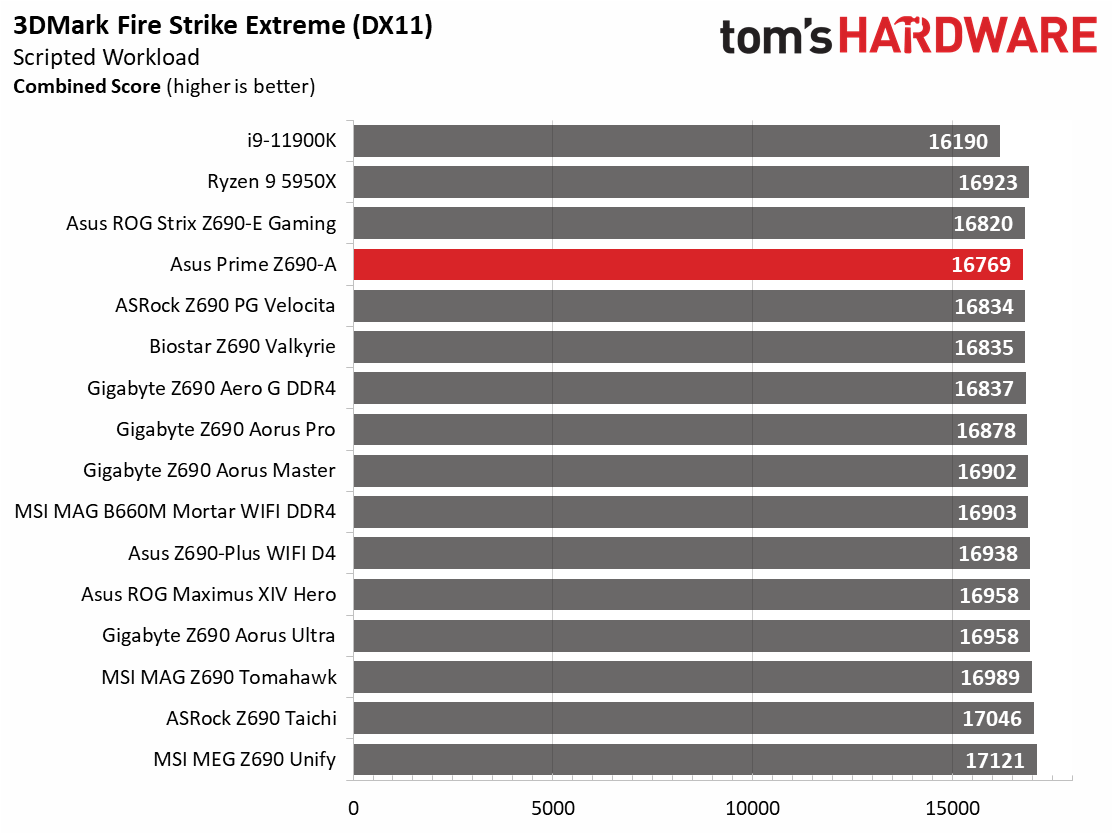

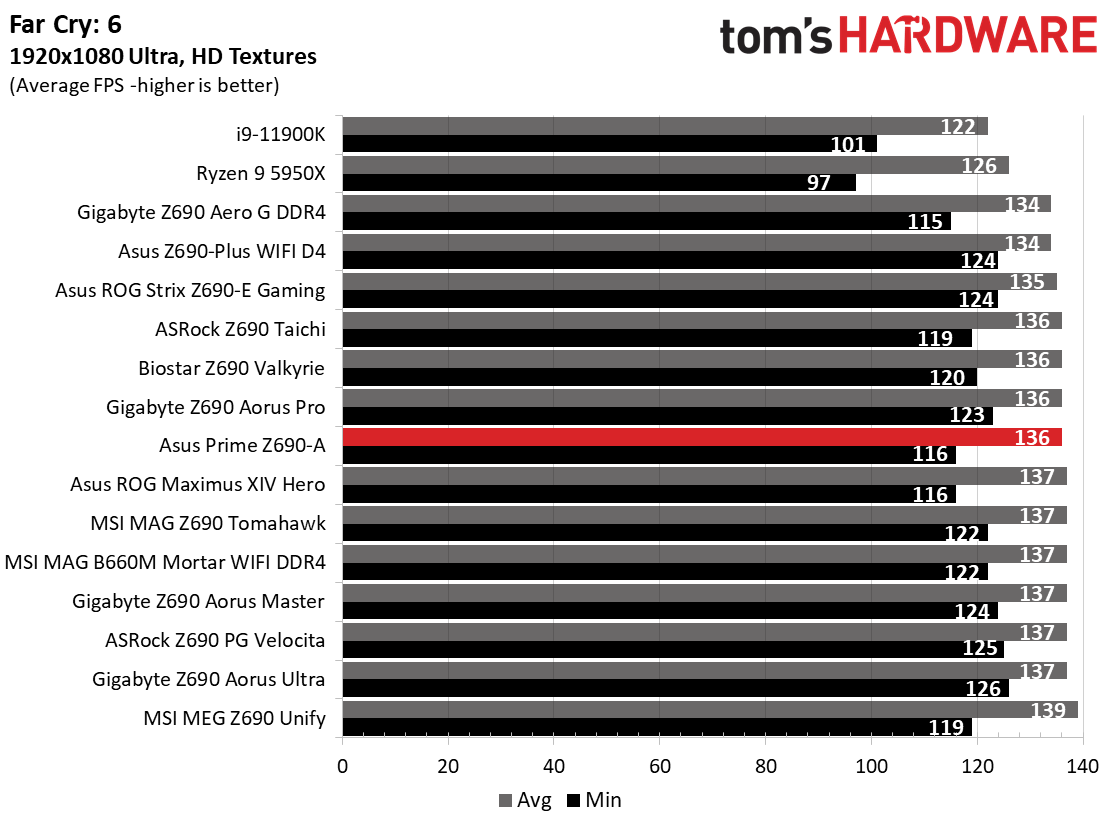

Starting with the launch of the Z690 chipset, we’ve updated our game tests. We’ve updated Far Cry: New Dawn to Far Cry 6 and shifted from F1 2020 to F1 2021. We run the games at 1920x1080 resolution using the Ultra preset (details listed above). As the resolution goes up, the CPU tends to have less impact. The goal with these settings is to determine if there are differences in performance at the most commonly used resolution with settings most people use or at least strive for. We expect the difference between boards in these tests to be minor, with most falling within the margin of error differences. We’ve also added a minimum FPS value, as that can affect your gameplay and immersion experience.
In F1 2021, the Prime Z690 PG averaged 165 fps with minimums of 141 fps, one of the faster sets of results we have (bested only by 142/166 results). For Far Cry 6, the test board averaged 136 fps, with a minimum of 116 fps. The minimums are some of the slower results we’ve seen.
Get Tom's Hardware's best news and in-depth reviews, straight to your inbox.
Our trend of not seeing significant differences among Z690 boards continues in our synthetic benchmarks. The Prime reached 14,452 on 3DMark Time Spy and 16,769 on Fire Strike Extreme, both on the lower side of average. Here again, the difference between the tested DDR5 boards is negligible.
Power Consumption / VRM Temperatures
We used AIDA64’s System Stability Test with Stress CPU, FPU and Cache enabled for power testing, using the peak power consumption value. The wattage reading is from the wall via a Kill-A-Watt meter to capture the entire PC minus the monitor. The only variable that changes is the motherboard; all other parts are the same.
At idle, the Prime Z690-A used 64W, landing in the middle of our results. Load wattage peaked at 288W, one of the lowest load values tested. Overall, the Prime is just slightly better than average as far as power use goes. In most cases, it would be difficult to see the difference in your electric bill between most of these boards.




VRM temperatures on our Prime topped out at close to 55 degrees Celsius during stock testing and around the same when overclocked. The Prime Z690-A is another example of a board using more power at stock speeds than when we set our overclock. VRM temps were a bit warmer than some others. However, they are running well within their specifications. You have nothing to worry about regarding the VRMs.
Overclocking With the Asus Prime Z690-A
Overclocking with Alder Lake is slightly different from what we’re used to due to the hybrid core configuration. Now, you can overclock the P and E cores separately, though they both use the same voltage domain. You can push one and not the other, or both, so there’s some flexibility. To that end, we set an overclock to 5.1 GHz across all P-cores and 4.1Ghz on all E-cores. This yields a 200 MHz bump on the P-cores and a 400 MHz increase on the E-cores. We’re topped out on the P-cores, primarily due to temperatures, but the more efficient E-cores still have some headroom.
Overclocking our Prime Z690-A and the flagship 8+8-core/24-thread i9-12900K proved relatively painless. Since we’ve found our required voltage with our first review, we plugged in that 1.25V value for Vcore, adjusted LLC to Mode 6 (up from the Asus suggested LLC4), and tested it successfully with minimal vdroop. According to CPUz, the voltage was 1.23V, so using LLC6 effectively mitigated the vdroop.
On the memory front, we set XMP, and off we went with our GSkill Trident Z5 DDR5 5600 CL36 Kit, yielding a 600 MHz increase from the maximum rating of the platform.
Bottom Line
The Asus Prime Z690-A is a mostly full-featured board that includes platform upgrades such as support for Alder Lake processors and PCIe 5.0 support for graphics. For $279.99, the board includes four PCIe 4.0 x4 M.2 sockets, 2.5 GbE (no Wi-Fi), a USB 3.2 Gen 2x2 (20 Gbps) Type-C port, last-gen flagship audio codec, upgraded power delivery and an updated appearance. Performance on our Prime board was average or above average, and overclocking wasn’t a concern. In all, it’s a well-performing SKU with several improvements over the Z590 version.
That’s not to say it isn’t without its shortcomings. First, the Prime color scheme can be polarizing. If you don’t want white in your build theme, you’ll have to look elsewhere. Outside of that, it looks like a less-expensive motherboard, as the heatsinks and shrouds don’t cover more of the bottom portion of the board as more expensive models do. The other shortcoming is a lack of USB ports on the rear IO. While you benefit from a 20 Gbps Type-C port (and another 10 Gbps Type-C port), there are only six Type-A ports. I don’t know about you, but I can use all of those right now. And if you plan to use more than four SATA ports, you’ll need an add-in card. Last but not least, there’s no integrated Wi-Fi here, while other similarly priced boards ship with wireless connectivity.
The Prime Z690-A’s primary competition is the Gigabyte Z690 Aorus Elite AX ($269.99), the MSI MAG Z690 Tomahawk ($301.99) and the ASRock Z690 Steel Legend ($249.99). The Gigabyte and MSI boards include Wi-Fi, six SATA ports and four M.2 sockets, with the ASRock sporting a whopping eight total SATA ports. The Gigabyte offering has the most rear USB ports, while the MSI is the only one using a current-generation audio codec.
If you’re looking to spend less than $300 on a Z690 motherboard and don’t need Wi-Fi or more than four SATA ports, the Prime Z690-A is a worthwhile option. But it’s not the most well-rounded at this price point.
That’s not to say it isn’t without its shortcomings. First, the Prime color scheme can be polarizing. If you don’t want white in your build theme, you’ll have to look elsewhere. Outside of that, it looks like a less-expensive motherboard, as the heatsinks and shrouds don’t cover more of the bottom portion of the board as more expensive models do. The other shortcoming is a lack of USB ports on the rear IO. While you benefit from a 20 Gbps Type-C port (and another 10 Gbps Type-C port), there are only six Type-A ports. I don’t know about you, but I can use all of those right now. And if you plan to use more than four SATA ports, you’ll need an add-in card. Last but not least, there’s no integrated Wi-Fi here, while other similarly priced boards ship with wireless connectivity.
The Prime Z690-A’s primary competition is the Gigabyte Z690 Aorus Elite AX ($269.99), the MSI MAG Z690 Tomahawk ($301.99) and the ASRock Z690 Steel Legend ($249.99). The Gigabyte and MSI boards include Wi-Fi, six SATA ports and four M.2 sockets, with the ASRock sporting a whopping eight total SATA ports. The Gigabyte offering has the most rear USB ports, while the MSI is the only one using a current-generation audio codec.
If you’re looking to spend less than $300 on a Z690 motherboard and don’t need Wi-Fi or more than four SATA ports, the Prime Z690-A is a worthwhile option. But it’s not the most well-rounded at this price point.
MORE: Best Motherboards
MORE: How To Choose A Motherboard
MORE: All Motherboard Content

Joe Shields is a staff writer at Tom’s Hardware. He reviews motherboards and PC components.
-
perpetual98 I think you've got some duplicate paragraphs there at the end. Or my browser is being dumbReply -
Co BIY Replyperpetual98 said:I think you've got some duplicate paragraphs there at the end. Or my browser is being dumb
I thought I was just tired.
Great board for review.
For me 6 USB plus front headers is plenty but I'm probably not a power user. USB is easy (and cheap) to add by card if needed later. 4 x M.2 is great.
I would like to see integrated Wi-Fi. (mainly for the Bluetooth) -
abepcnt i am having a very bad time with this board, the 4 USBs 3.1 are not working. i contacted Asus customer service here in Sydney, they are very unprofessional and they have no idea about the M/B, they gave me a very stupid answer and they asked me to pay $110 for repair, this board is 2 weeks old and still under the warranty, i do not recommended it at all.Reply

